 |
 |
 |
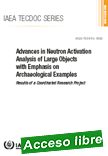 |
Advances in Neutron Activation Analysis of Large Objects with Emphasis on Archaeological Examples - Results of a Coordinated Research Project
IAEA TECDOC, 2018, 72 p.
This publication is a compilation of the main results and findings of an IAEA coordinated research project (CRP). In particular, it discusses an innovative variation of neutron activation analysis (NAA) known as large sample NAA (LSNAA). There is no other way to measure the bulk mass fractions of the elements present in a |
large sample (up to kilograms in mass) non-destructively. Examples amenable to LSNAA include irregularly shaped archaeological artefacts, excavated rock samples, large samples of assorted ore, and finished products, such as nuclear reactor components. Advantages of LSNAA applications, limitations and scientific and technological requirements are described in this publication, which serves as a reference of interest not only to the NAA experts, research reactor personnel, and those considering this technique, but also to various stakeholders and users such as researchers, industrialists, environmental and legal experts, and administrators.
Extraído de: https://www-pub.iaea.org/books/IAEABooks/12308/Advances-in-Neutron-Activation-Analysis-of-Large-Objects-with-Emphasis-on-Archaeological-Examples |
 |
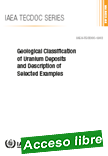 |
Geological Classification of Uranium Deposits and Description of Selected Examples
IAEA TECDOC, 2018, 428 p.
With the increased level of investigation into uranium deposits in recent years, a wealth of new information has become available, which has made it possible to investigate some of the least understood aspects of uranium metallogeny. This publication defines a new classification scheme, which is simple and descriptive, but flexible enough to encompass the recent advances |
in our understanding of uranium geology and deposit genesis. It contains improved definition of the deposit types, supported by type examples of those deposits for which good data are available, but not well described in previous literature. Along with the descriptive information, new data on uranium resources available for each deposit type are also provided.
Extraído de: https://www-pub.iaea.org/books/IAEABooks/12346/Geological-Classification-of-Uranium-Deposits-and-Description-of-Selected-Examples |
 |
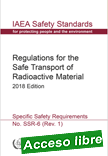 |
Regulations for the Safe Transport of Radioactive Material (2018 Edition)
IAEA Safety Standards Series , 2018, 165 p.
The objective of these Regulations is to establish requirements that must be satisfied to ensure safety and to protect people, property, and the environment from harmful effects of ionizing radiation during the transport of radioactive material. This protection is achieved by requiring: (a) Containment of the radioactive contents; (b) Control of external dose rate; (c)
|
Prevention of criticality; (d) Prevention of damage caused by heat.
These requirements are satisfied firstly by applying a graded approach to contents limits for packages and conveyances and to performance standards applied to package designs, depending upon the hazard of the radioactive contents. Secondly, they are satisfied by imposing conditions on the design and operation of packages and on the maintenance of packagings, including consideration of the nature of the radioactive contents. Thirdly, they are satisfied by requiring administrative controls, including, where appropriate, approval by competent authorities. Finally, further protection is provided by making arrangements for planning and preparing emergency response to protect people, property and the environment.
Extraído de: https://www-pub.iaea.org/books/IAEABooks/12288/Regulations-for-the-Safe-Transport-of-Radioactive-Material-2018-Edition |
 |
 |
L’AEN et sa misión - L’Agence pour l’énergie nucléaire (AEN) est une institution semi-autonome au sein de l’Organisation de coopération et de développement économiques (OCDE) qui a son siège aux portes de Paris, France. L’Agence a pour misión d’aider ses pays membres à maintenir et à approfondir, par l’intermédiaire de la coopération internationale, les bases
scientifiques, technologiques et juridiques indispensables à une utilisation sûre, respectueuse de l’environnement et économique de l’énergie nucléaire à des fins pacifiques.
|
Extraído de: http://www.oecd-nea.org/pub/activities/ar2017/ar2017-fr.pdf
|
 |
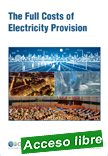 |
The Full Costs of Electricity Provision
Nuclear Energy Agency (NEA), 13/04/18, 212 p.
Electricity provision touches upon every facet of life in OECD and non-OECD countries alike, and choosing how this electricity is generated - whether from fossil fuels, nuclear energy or renewables - affects not only economic outcomes but individual and social well-being in the broader sense. Research on the overall costs of electricity is an ongoing effort, as only certain costs of electricity provision are perceived directly by producers and consumers. Other costs, such as the health impacts of air pollution, damage from climate change or the effects on the |
electricity system of small-scale variable production are not reflected in market prices and thus diminish well-being in unaccounted for ways.
Accounting for these social costs in order to establish the full costs of electricity provision is difficult, yet such costs are too important to be disregarded in the context of the energy transitions currently under way in OECD and NEA countries. This report draws on evidence from a large number of studies concerning the social costs of electricity and identifies proven instruments for internalising them so as to improve overall welfare.
The results outlined in the report should lead to new and more comprehensive research on the full costs of electricity, which in turn would allow policy makers and the public to make better informed decisions along the path towards fully sustainable electricity systems.
Extraído de:http://www.oecd-nea.org/tools/publication?query=§or=&lang=&period=6m&sort=title&filter=1#p7298
|
 |
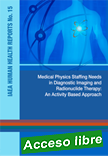
|
Medical Physics Staffing Needs in Diagnostic Imaging and Radionuclide Therapy: An Activity Based Approach
IAEA Human Health Reports, 2018, 23 p.
Over the last decades, the rapid technological development of diagnostic and interventional radiology and nuclear medicine has made them major tools of modern medicine. However, at the same time the involved risks, the growing number of procedures and the increasing complexity of the procedures require competent professional staff to ensure safe and effective patient diagnosis, treatment and management. Medical physicists (or clinically |
qualified medical physicists) have been recognized as vital health professionals with important and clear responsibilities related to quality and safety of applications of ionizing radiation in medicine. This publication describes an algorithm developed to determine the recommended staffing levels for clinical medical physics services in medical imaging and radionuclide therapy, based on current best practice, as described in international guidelines.
Extraído de: https://www-pub.iaea.org/books/IAEABooks/12208/Medical-Physics-Staffing-Needs-in-Diagnostic-Imaging-and-Radionuclide-Therapy-An-Activity-Based-Approach
|
 |
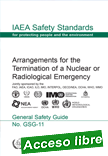 |
Arrangements for the Termination of a Nuclear or Radiological Emergency
IAEA Safety Standards Series, 2018, 189 p.
This publication provides guidance and recommendations on arrangements to be made at the preparedness stage, as part of overall emergency preparedness, for the termination of a nuclear or radiological emergency and the subsequent transition from the emergency exposure situation to either a planned exposure situation or an existing exposure situation. It elaborates the
|
prerequisites that need to be fulfilled so that responsible authorities can declare the nuclear or radiological emergency ended and it gives detailed guidance on adapting and lifting protective actions. This publication, jointly sponsored by 10 international organizations (FAO, IAEA, ICAO, ILO, IMO, INTERPOL, OECD/NEA, UN OCHA, WHO and WMO) is intended to assist Member States in the application of IAEA Safety Standards Series Nos GSR Part 3 and GSR Part 7.
Extraído de: https://www-pub.iaea.org/books/IAEABooks/12269/Arrangements-for-the-Termination-of-a-Nuclear-or-Radiological-Emergency |
 |
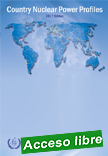 |
Country Nuclear Power Profiles - 2017 Edition
IAEA Non-serial Publications , 2018, s. p.
The Country Nuclear Power Profiles compile background information on the status and development of nuclear power programmes in Member States. The publication summarizes organizational and industrial aspects of nuclear power programmes and provides information about the relevant legislative, regulatory and international framework in each State. Its descriptive and statistical overview of the overall economic, energy
|
and electricity situation in each State and its nuclear power framework is intended to serve as an integrated source of key background information about nuclear power programmes throughout the world. This 2017 edition, issued on CD-ROM, contains updated country information for 50 States.
Extraído de: https://www-pub.iaea.org/books/IAEABooks/12350/Country-Nuclear-Power-Profiles |
 |
|
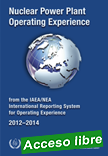
|
Nuclear Power Plant Operating Experience from the IAEA/NEA International Reporting System for Operating Experience 2012–2014
IAEA Non-serial Publications , 2018, 53 p.
The International Reporting System for Operating Experience (IRS) is an essential element of the international operating experience feedback system for nuclear power plants. Its fundamental objective is to contribute to improving safety of commercial nuclear power plants which are operated worldwide. IRS reports contain
|
information on events of safety significance with important lessons learned which assist in reducing recurrence of events at other plants. This sixth publication, covering the period 2012 – 2014, follows the structure of the previous editions. It highlights important lessons based on a review of the approximately 240 event reports received from the participating countries over this period.
Extrído de: https://www-pub.iaea.org/books/IAEABooks/11154/Nuclear-Power-Plant-Operating-Experience
|
 |
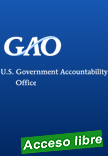 |
Nuclear Nonproliferation: The Administration's 2015 Plan and 2017 Update for Nuclear Proliferation Verification and Monitoring Generally Did Not Address Reporting Requirements
Government Accountability Office (GAO - US), June 18, 2018, 11 p.
Federal law directed the administration to submit and update an interagency plan to Congress for verifying and monitoring the proliferation of nuclear weapons and materials.
We looked at the plan and update to determine if they met reporting requirements.
|
We found that the documents—which were two and four pages long, respectively—did not address several requirements and lacked key details. They did not include: An interagency plan for verification and monitoring; A specific plan for building cooperation to improve inspections and monitoring; A research and development program to improve monitoring.
Extraído de: https://www.gao.gov/products/GAO-18-505R?utm...
|
 |
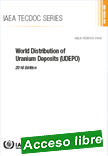 |
World Distribution of Uranium Deposits (UDEPO) - 2016 Edition
IAEA TECDOC, 2018, 260 p.
The World Distribution of Uranium Deposits (UDEPO) is a database on technical, geographical and geological characteristics of worldwide uranium deposits. The current version presents and describes modifications made since 2009. It presents a preliminary statistical and tabular analysis of the data for the first time, with a view to ensuring that the data is robust enough to serve as a basis for more sophisticated analysis in the future.
|
|

|
|
|
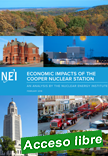 |
Economic Impacts of the Cooper Nuclear Station
Nuclear Energy Institute (NEI - US), February 2018, 13 p.
The Cooper Nuclear Station, located along the Missouri River in the southeast corner of Nebraska, has long been a vital part of the region’s energy portfolio, providing reliable electricity since it began operating in 1974.
In addition to this reliable, carbon-free electricity, the plant supports hundreds of direct jobs. Employee involvement in their community also makes Cooper a significant social and economic contributor to Nebraska. Cooper is Nebraska’s largest single source of carbonfree electricity. 2018
|
total estimated economic benefits for the Cass, Johnson, Nemaha, Otoe and
Richardson counties surrounding the Cooper Nuclear Station include: $66 million in economic output from plant operations; $63 million increase in gross state product and $70 million in disposable personal income.
Extraído de: Nuclear Energy Institute (NEI - US), March 2018, 19 p.
|
| |
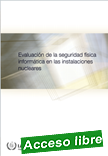 |
Evaluación de la Seguridad Física Informática en las Instalaciones Nucleares
OIEA, 2018, 84 p.
En esta publicación se describe una metodología para evaluar la seguridad física informática en las instalaciones nucleares. La metodología puede adaptarse fácilmente para efectuar evaluaciones en instalaciones en que haya otros materiales radiactivos.
Las orientaciones se han redactados de modo que se puedan aplicar en múltiples contextos, por ejemplo en:
|
— una misión específica del servicio de asesoramiento sobre seguridad física informática,
organizada por el OIEA a petición de un Estado Miembro;
— un módulo específico sobre seguridad física informática integrado en otras misiones organizadas por el OIEA, por ejemplo una misión del Servicio Internacional de Asesoramiento sobre Protección Física (IPPAS) en que el dominio de la protección física sea el objeto de la evaluación;
— evaluaciones realizadas por una autoridad competente nacional en emplazamientos e instalaciones de un Estado;
— autoevaluaciones realizadas a nivel de una instalación o de una organización;
— una evaluación de la seguridad física informática de los proveedores y terceros que presten apoyo a instalaciones nucleares.
La metodología permite evaluar las prácticas existentes en una instalación con el fin de fortalecer la organización y sus procedimientos y prácticas. Tiene en cuenta las orientaciones impartidas en las publicaciones de la Colección de Seguridad Física Nuclear del OIEA, las normas internacionales y la buena práctica apoyada por la comunidad internacional. Está estructurada como un examen de alto nivel del marco para la seguridad física informática, con un examen a nivel funcional de las medidas y los procedimientos establecidos para ejecutar ese marco, prestando atención específica a las funciones de seguridad nuclear tecnológica y física que puedan ofrecer los sistemas informáticos. (…)
Extraído de:https://www-pub.iaea.org/books/IAEABooks/12276/Conducting-Computer-Security-Assessments-at-Nuclear-Facilities
|
| |
| |
|
|
| |
| |
|
|
|
